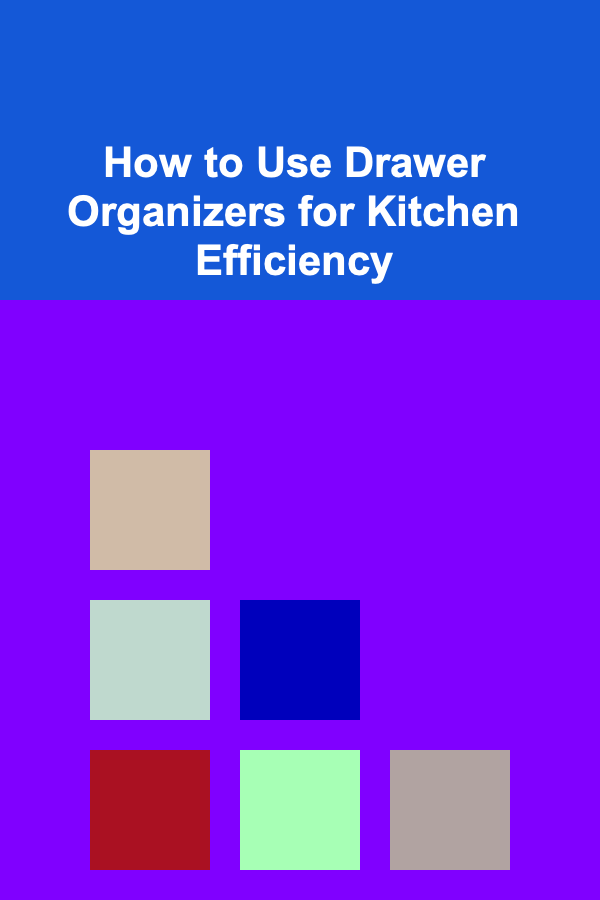
How to Use Drawer Organizers for Kitchen Efficiency
ebook include PDF & Audio bundle (Micro Guide)
$12.99$10.99
Limited Time Offer! Order within the next:

The kitchen is often regarded as the heart of the home---an essential space for cooking, gathering, and creating cherished memories. However, a disorganized kitchen can lead to frustration, wasted time, and inefficiency. One effective solution for maintaining order in this vital area is the use of drawer organizers. This comprehensive guide will explore the various types of drawer organizers, their benefits, how to effectively implement them in your kitchen, and tips for maintaining an organized kitchen environment.
The Importance of Kitchen Organization
1. Enhances Efficiency
An organized kitchen allows for quick access to utensils and ingredients, making meal preparation smoother and faster. When everything has a designated place, you spend less time searching and more time cooking.
2. Reduces Stress
A cluttered kitchen can create anxiety and overwhelm, especially when preparing meals for family or guests. An organized space promotes a calm atmosphere, making it easier to focus on the task at hand.
3. Improves Safety
Keeping knives, sharp utensils, and other tools stored properly reduces the risk of accidents in the kitchen. Drawer organizers help contain these items and keep them out of reach of children or pets.
4. Maximizes Space
Drawer organizers make efficient use of available space, ensuring that every corner of your kitchen is utilized. They prevent overcrowding and help maintain an aesthetic appeal.
Understanding Drawer Organizers
Before diving into implementation, it's important to understand the various types of drawer organizers available and their specific uses.
1. Types of Drawer Organizers
a. Cutlery Trays
Typically made from plastic, bamboo, or wood, cutlery trays are designed to hold forks, spoons, knives, and other flatware. They generally feature segmented compartments for easy categorization.
b. Utensil Holders
These organizers are specifically designed for larger cooking utensils like spatulas, ladles, and serving spoons. They come in various materials and styles, including upright holders that allow quick access.
c. Spice Drawer Inserts
Spice drawer inserts provide dedicated compartments for spices, allowing you to see all your options at a glance. Some models even come with labels for easy identification.
d. Adjustable Dividers
Adjustable dividers can be customized to fit various drawer sizes and shapes. They allow you to create personalized sections based on your needs.
e. Drawer Bins
These open-top bins can be used to group similar items together, such as baking tools, measuring cups, or small kitchen gadgets.
2. Materials Used
- Plastic: Affordable and lightweight, plastic organizers are easy to clean.
- Bamboo: Offers a natural aesthetic and durability; perfect for those who prefer eco-friendly options.
- Wood: Provides a classic look and sturdiness but requires more maintenance.
- Metal: Often used for heavier items; metal organizers can add an industrial touch to your kitchen.
Step-by-Step Guide to Implementing Drawer Organizers
Step 1: Assess Your Kitchen Needs
Evaluate Your Current Setup
Begin by examining your existing kitchen drawers and identifying areas that require organization. Take note of any clutter or items that are difficult to access.
List Items to Organize
Create a list of items that need organizing based on categories:
- Cutlery
- Cooking Utensils
- Baking Tools
- Spices
- Miscellaneous Gadgets
Step 2: Measure Your Drawers
Obtain Accurate Measurements
To ensure that your chosen organizers fit perfectly within your drawers, measure the width, depth, and height of each drawer. This will help you select organizers that maximize space without causing overcrowding.
Step 3: Choose the Right Organizers
Research Options
Once you have measured your drawers, begin researching different organizer options. Consider factors such as:
- Material: Choose based on aesthetics and durability.
- Size: Ensure compatibility with your drawer dimensions.
- Functionality: Opt for organizers that meet your specific needs.
Step 4: Empty the Drawers
Clear Out Everything
Before placing new organizers in the drawers, empty them completely. This allows for a thorough cleaning and gives you a fresh start.
Clean the Drawers
Use mild soap and water to wipe down the drawers thoroughly. Allow them to dry completely before adding organizers, preventing moisture buildup.
Step 5: Sort Items into Categories
Group Similar Items
With your empty drawers, sort through the items you removed, grouping similar items together. For example, keep all cutlery in one category and all cooking utensils in another.
Step 6: Place Organizers in Drawers
Arrange Organizers
Start placing the organizers in the drawers, arranging them by category. Here are some suggestions:
- Top Drawer: Place cutlery trays or utensil holders for easy access.
- Middle Drawer: Use adjustable dividers for cooking utensils, measuring cups, and mixing bowls.
- Bottom Drawer: Store bulkier items or rarely used tools.
Step 7: Label for Clarity
Add Labels
Consider labeling organizers to enhance clarity, especially if multiple people use the kitchen. Use a label maker or write directly on labels to indicate contents.
Step 8: Maintain Regularly
Schedule Routine Checks
Regularly assess the organization system to ensure it remains functional. Aim to check every few months, particularly after holidays or events when your kitchen may experience increased use.
Step 9: Adjust as Needed
Be Flexible
As you cook and interact with your kitchen, you might find that certain items would be better placed elsewhere. Feel free to rearrange organizers based on your evolving needs.
Practical Applications of Drawer Organizers in Specific Kitchen Areas
1. Cutlery Drawer
a. Use a Compartment Tray
- Organize forks, knives, and spoons separately.
- Include a section for serving utensils like tongs.
b. Incorporate a Knife Block
If space allows, consider a knife block in the drawer to keep knives sharp and safe.
2. Cooking Utensil Drawer
a. Use a Deep Organizer
Select a deeper tray to accommodate larger cooking utensils like whisks and spatulas.
b. Separate By Type
- Group similar utensils together (e.g., wooden spoons, silicone spatulas, etc.)
- Include a small bin for specialty tools like pastry brushes.
3. Spice Drawer
a. Utilize Inserts
Choose spice drawer inserts with labeled compartments for easy identification.
b. Consider Magnetic Containers
Magnetic spice containers allow for easy visibility and access while freeing up drawer space.
4. Baking Tool Drawer
a. Designate an Area for Baking Supplies
Utilize bins for measuring cups, spoons, and baking utensils to streamline the baking process.
b. Include Specialty Tools
Consider adding a section for cookie cutters, rolling pins, and silicone mats.
5. Miscellaneous Gadgets Drawer
a. Group Kitchen Gadgets
Use a large bin to store miscellaneous gadgets like peelers, can openers, and measuring tools.
b. Include a Snack Bag Section
Designate a small area for snacks or items used frequently, such as napkins or straws.
Tips for Maintaining an Efficient Kitchen with Drawer Organizers
1. Avoid Overcrowding
Be mindful not to overload drawers with too many items, as this can lead to chaos. If a drawer becomes crowded, consider downsizing.
2. Regularly Clean and Reset
Make it a habit to clean your drawer organizers every few months. This keeps everything looking fresh and maintains hygiene.
3. Stay Inspired
Keep your kitchen organized and inspiring by regularly reassessing your setup. Look for new organizational solutions or trends that can enhance functionality.
4. Involve Family Members
Educate family members about the organization system to ensure everyone understands where items belong. Encourage them to maintain the system actively.
Conclusion
Using drawer organizers in your kitchen significantly enhances efficiency, reduces stress, and promotes a visually appealing environment. By implementing an organized system tailored to your specific needs, you will transform your kitchen into a harmonious workspace that fosters creativity and joy in cooking.
Through consistent assessment and adaptation, you can maintain an efficient kitchen that meets the demands of your lifestyle. Embrace the power of drawer organizers, and discover the satisfaction of an organized kitchen---one drawer at a time. With careful planning, thoughtful arrangement, and regular maintenance, your kitchen can evolve into a well-oiled machine that inspires culinary exploration and creates lasting memories.

Becoming a Successful Operations Director: Best Practices for Operational Excellence
Read More
How to Create a DIY Craft Organizer from Recyclables
Read More
How to Optimize Storage Under Your Bed for Seasonal Items
Read More
How to Personalize Your Online Learning Environment
Read More
How to Research the Ethics of Human Germline Editing
Read More
How to Use Vertical Storage to Save Space in Your Home
Read MoreOther Products

Becoming a Successful Operations Director: Best Practices for Operational Excellence
Read More
How to Create a DIY Craft Organizer from Recyclables
Read More
How to Optimize Storage Under Your Bed for Seasonal Items
Read More
How to Personalize Your Online Learning Environment
Read More
How to Research the Ethics of Human Germline Editing
Read More